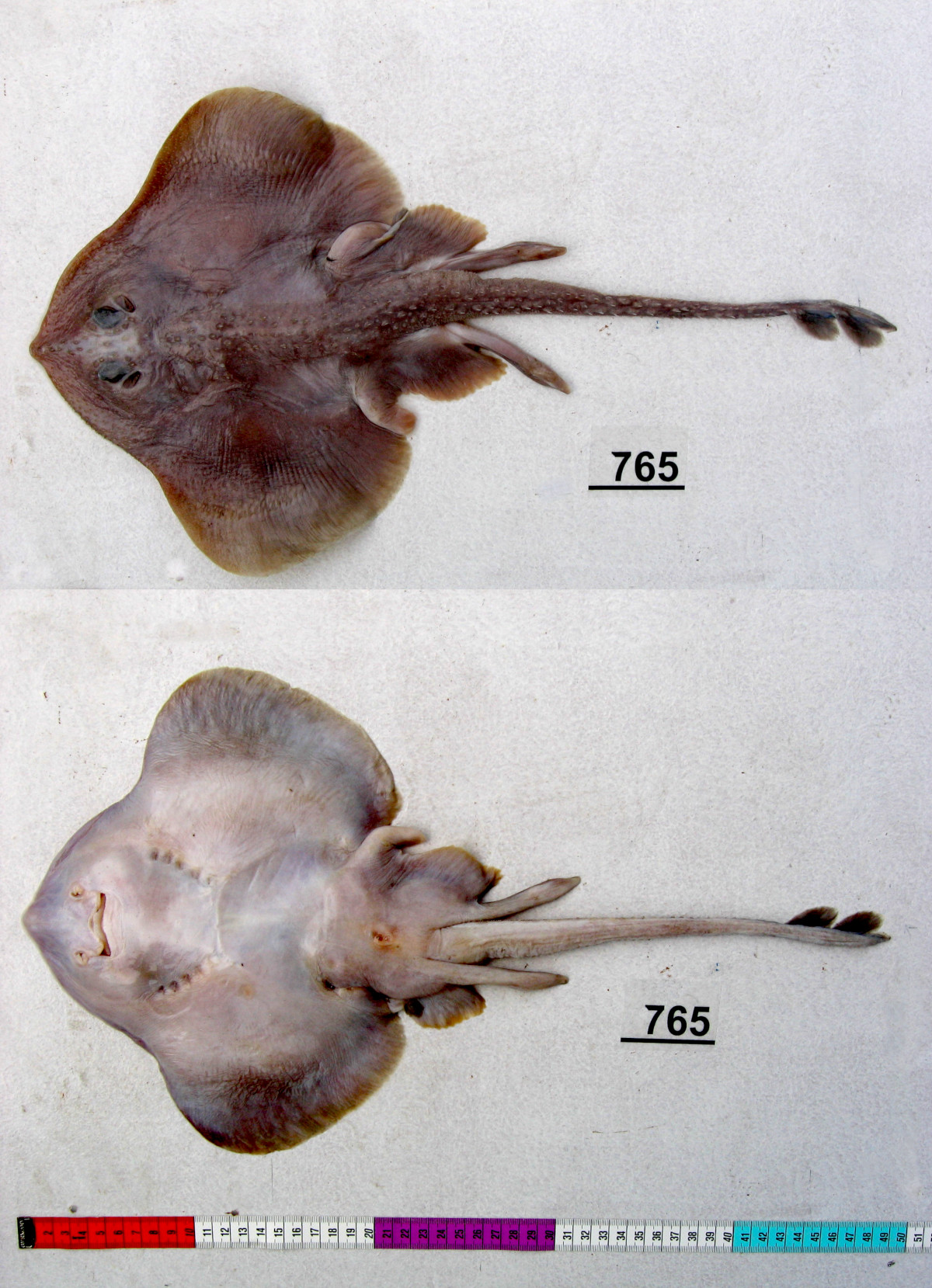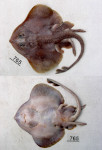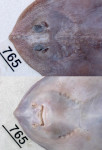Rajella fyllae
(Lütken, 1887)
Round ray
Classification: Elasmobranchii Rajiformes Rajidae
Reference of the original description
Korte Bidrag til nordisk Ichthyographi. VI. En for Grønlandshavet ny Rokke-art (Raja Fyllae n. sp. ad int.) m. m. Videnskabelige Meddelelser fra den Naturhistoriske Forening i Kjøbenhavn, Aaret 1887, 1–4
Korte Bidrag til nordisk Ichthyographi. VI. En for Grønlandshavet ny Rokke-art (Raja Fyllae n. sp. ad int.) m. m. Videnskabelige Meddelelser fra den Naturhistoriske Forening i Kjøbenhavn, Aaret 1887, 1–4
Image of the original description
.jpg)
Rajella fyllae (Lütken, 1887)
.jpg)
Rajella fyllae (Lütken, 1887)
Synonyms / new combinations and misspellings
Breviraja marklei, Raia fyllae, Raja fyllae, Raja fyllae lipacantha, Raja (Rajella) fyllae
Breviraja marklei, Raia fyllae, Raja fyllae, Raja fyllae lipacantha, Raja (Rajella) fyllae
Types
Rajella fyllae
Holotype: ZMUC: P08488;
Breviraja marklei
Holotype: CMNFI: 1986-0036.1; Paratype: MCZ: 63198; ROM: 50330; USNM: 277973;
Raja fyllae lipacantha
Syntype: ZMB: 18292 ZMUC: P08717; ZMUC: P08718; ZMUC: P08723; ZMUC: P08724; ZMUC: P08725; ZMUC: P08726; ZMUC: P08727; ZMUC: P08728; ZMUC: P08729; ZMUC: P08730; ZMUC: P08731; ZMUC: P08732; ZMUC: P08733; ZMUC: P08734; ZMUC: P08735; ZMUC: P08736;
Rajella fyllae
Holotype: ZMUC: P08488;
Breviraja marklei
Holotype: CMNFI: 1986-0036.1; Paratype: MCZ: 63198; ROM: 50330; USNM: 277973;
Raja fyllae lipacantha
Syntype: ZMB: 18292 ZMUC: P08717; ZMUC: P08718; ZMUC: P08723; ZMUC: P08724; ZMUC: P08725; ZMUC: P08726; ZMUC: P08727; ZMUC: P08728; ZMUC: P08729; ZMUC: P08730; ZMUC: P08731; ZMUC: P08732; ZMUC: P08733; ZMUC: P08734; ZMUC: P08735; ZMUC: P08736;
Description :
Citation: Rajella fyllae (Lütken, 1887): In: Database of modern sharks, rays and chimaeras, www.shark-references.com, World Wide Web electronic publication, Version 05/2025
Please send your images of "Rajella fyllae" to info@shark-references.com

Rajella fyllae (Lütken, 1887), ERB 0765, male, 26, 8 cm DW, 47, 5 cm TL, France © Frederik H. Mollen (Elasmobranch Research Belgium)

Rajella fyllae (Lütken, 1887), ERB 0765, male, 26, 8 cm DW, 47, 5 cm TL, France © Frederik H. Mollen (Elasmobranch Research Belgium)
Common names
 Fyllasrochen,
Fyllasrochen,  Raya redonda,
Raya redonda,  Raie ronde,
Raie ronde,  Round ray,
Round ray,  Round skate,
Round skate,  Sandy skate
Sandy skate
 Fyllasrochen,
Fyllasrochen,  Raya redonda,
Raya redonda,  Raie ronde,
Raie ronde,  Round ray,
Round ray,  Round skate,
Round skate,  Sandy skate
Sandy skate
Short Description
Snout is short and obtuse. Midbelt of its disc and upper surface of its tail are rough with large thorns in irregular rows. Upper surface ash gray to chocolate brown. Lower surface white, grayish white, pale gray or light fawn color, sooty patches on pelvic fins and axils of pectoral fins [199]. Diet: Barents Sea (data base: of 85 stomachs examined): Round skate fed mainly on bottom benthos, especially Polychaeta (31% by mass) and Gammaridae (14% by mass). Northern shrimp (26% by mass) and fisheries waste (10% by mass) were also major components of their diets. Fish (mostly capelin and young cod) occurred in small quantities. Small individuals (<35 cm TL) consumed exclusively benthos (Polychaeta and Gammaridae) and only those of the 36–40 cm TL-group and larger fed on bigger prey. The largest skates (51–55 cm TL-group) had a high proportion of small benthic organisms (<30–40%). [5910];
Snout is short and obtuse. Midbelt of its disc and upper surface of its tail are rough with large thorns in irregular rows. Upper surface ash gray to chocolate brown. Lower surface white, grayish white, pale gray or light fawn color, sooty patches on pelvic fins and axils of pectoral fins [199]. Diet: Barents Sea (data base: of 85 stomachs examined): Round skate fed mainly on bottom benthos, especially Polychaeta (31% by mass) and Gammaridae (14% by mass). Northern shrimp (26% by mass) and fisheries waste (10% by mass) were also major components of their diets. Fish (mostly capelin and young cod) occurred in small quantities. Small individuals (<35 cm TL) consumed exclusively benthos (Polychaeta and Gammaridae) and only those of the 36–40 cm TL-group and larger fed on bigger prey. The largest skates (51–55 cm TL-group) had a high proportion of small benthic organisms (<30–40%). [5910];
Distribution
Northeast Atlantic: Spitsbergen [=Svalbard] to southern Norway, southern Greenland, Iceland, Faeroe Islands to Shetlands, western coasts of British Isles and Bay of Biscay. Northwest Atlantic: Greenland to Nova Scotia, Canada. Source: www.gbif.org
Northeast Atlantic: Spitsbergen [=Svalbard] to southern Norway, southern Greenland, Iceland, Faeroe Islands to Shetlands, western coasts of British Isles and Bay of Biscay. Northwest Atlantic: Greenland to Nova Scotia, Canada. Source: www.gbif.org
Human uses
fisheries: of no interest
fisheries: of no interest
Biology
Oviparous, paired eggs are laid. Embryos feed solely on yolk [733]. Distinct pairing with embrace. Young may tend to follow large objects, such as their mother [17086]. Found in deeper shelf and slope waters, in 3-5.5°C water temperature (6902). Benthic (Ref. 58426). Feed on all kinds of bottom animals with preference for invertebrates [7182] like copepods, amphipods and mysids [199]. A nematode, Proleptus mackenzei is a known parasite of the species (Ref. 5951).
Oviparous, paired eggs are laid. Embryos feed solely on yolk [733]. Distinct pairing with embrace. Young may tend to follow large objects, such as their mother [17086]. Found in deeper shelf and slope waters, in 3-5.5°C water temperature (6902). Benthic (Ref. 58426). Feed on all kinds of bottom animals with preference for invertebrates [7182] like copepods, amphipods and mysids [199]. A nematode, Proleptus mackenzei is a known parasite of the species (Ref. 5951).
Remarks
shark-references Species-ID=5863;
shark-references Species-ID=5863;
Parasites (arranged by Jürgen Pollerspöck)
Nematoda
Nematoda
- Proleptus mackenziei Williams & Heddwyn, 1978 [13251]

















